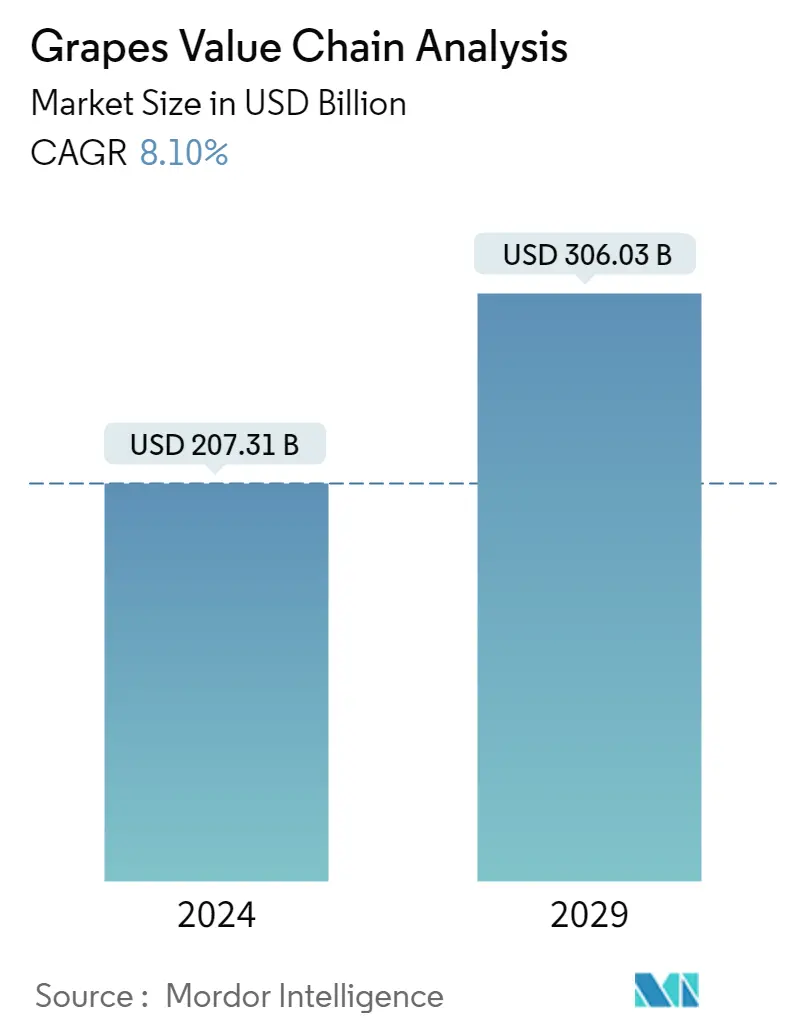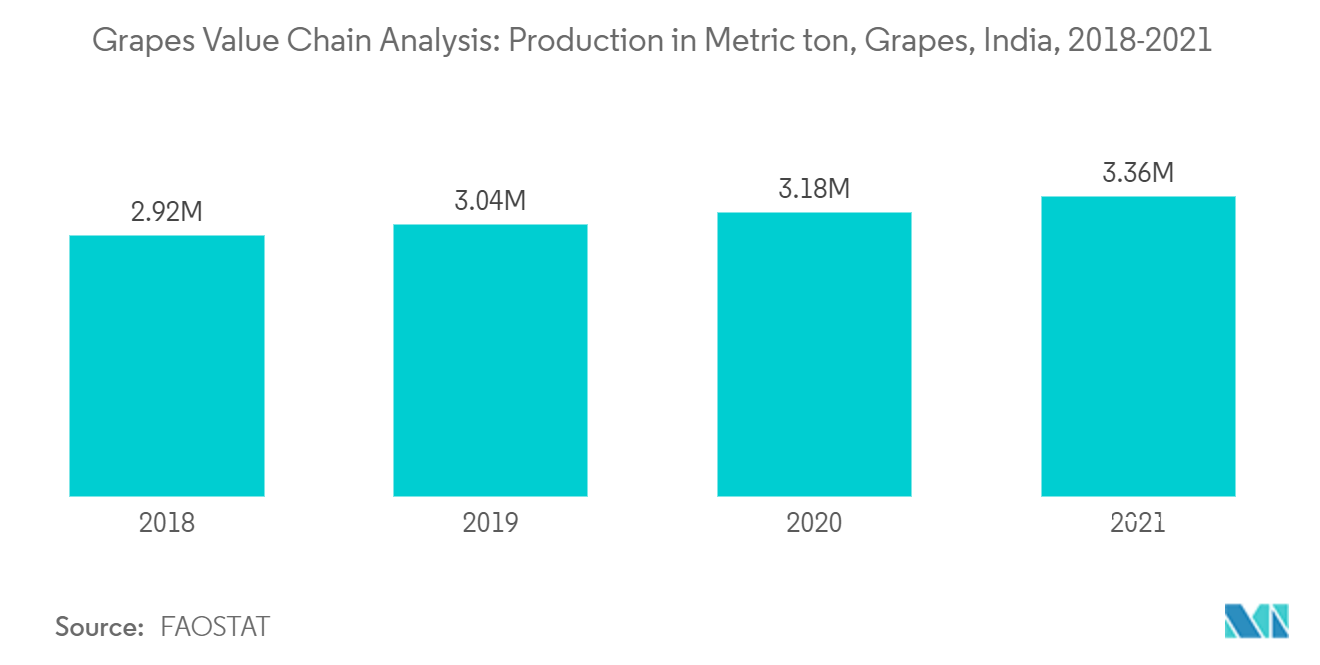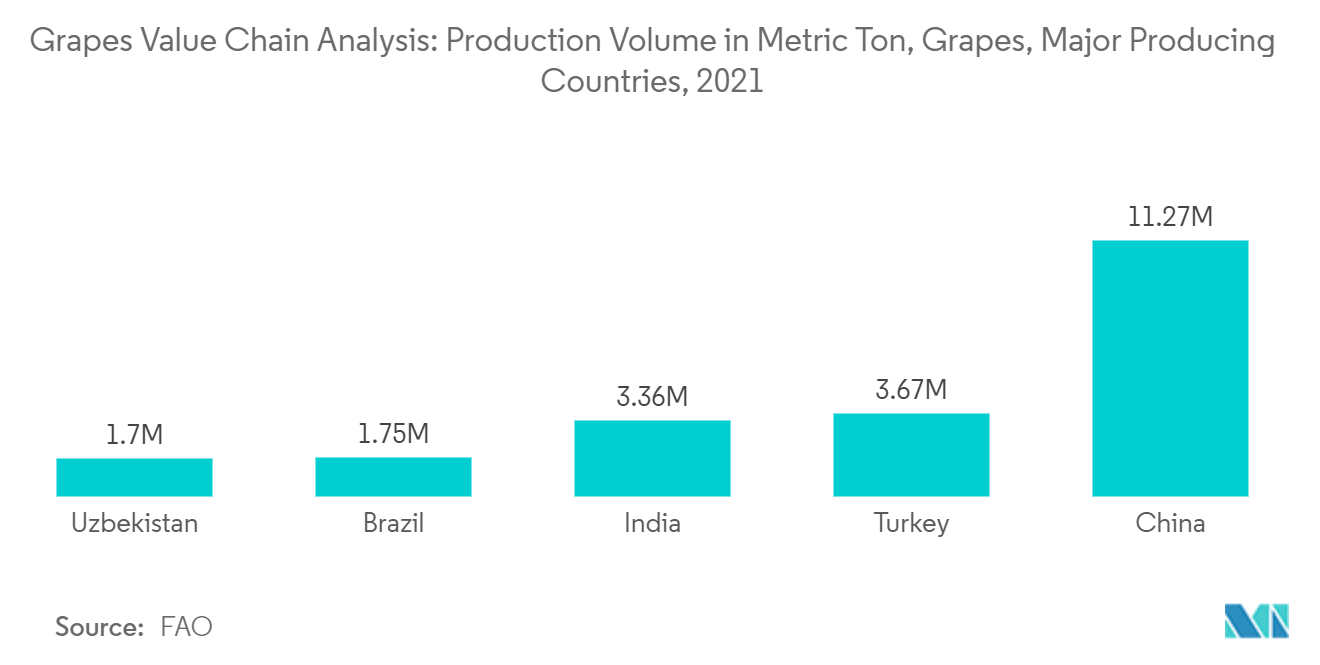Grapes Value Chain Analysis Market Size

| Study Period | 2019 - 2029 |
| Market Size (2024) | USD 207.31 Billion |
| Market Size (2029) | USD 306.03 Billion |
| CAGR (2024 - 2029) | 8.10 % |
| Fastest Growing Market | Asia-Pacific |
| Largest Market | Asia-Pacific |
Major Players*Disclaimer: Major Players sorted in no particular order |
Grapes Value Chain Analysis Market Analysis
The Grapes Market size is estimated at USD 207.31 billion in 2024, and is expected to reach USD 306.03 billion by 2029, growing at a CAGR of 8.10% during the forecast period (2024-2029).
- Grapes are one of the largest fruit crops, with approximately 6,729,198 hectares of area harvested worldwide in 2021. According to a United States Department of Agriculture report, global table grape production in 2021 reached about 25.5 million metric tons (MMT). Table grapes and wine grapes are the two major types of grapes grown worldwide, out of which table grapes are freshly consumable.
- The Farmers are the primary stakeholder in the grape value chain, and they involve in the process of production of grapes. Farmers incur various costs, including seed, labor, tractor, and transportation. Aggregators/farmer co-operatives are the stakeholders in the grape value chain next to farmers.
- After aggregators/farmer co-operatives exporters come into the role, the major exporters of grapes are the United States, Peru, Chile, and the Netherlands. The costs incurred by exporters include labor, transportation, overheads, bulk packaging, fertilizer, crop protection, and insurance charges. Exporters also pay insurance for the value of the commodity and vehicle they are exporting to safeguard the capital invested, despite the adverse situations during transport from one port to another.
- Moving forward in the chain, importers, and wholesalers come next to exporters. And the final stakeholders in the grape value chain are retailers. Costs incurred by the retailers include transportation, overheads, and packaging costs.
- Developing new varieties of fresh grapes requires significant investment and experimentation. The R&D activities and launching of. It produces grapes varieties tiesfreshmanainly being carried out around the globe by public and private firms for future development in the grape market. For instance, recently, Embrapa, the Brazilian Agricultural Research Corporation, Semiárido unveiled the first table grape variety BRS Tainá to be bred exclusively for production in the northeast of Brazil. BRS Tainá is a white seedless variety with a 'neutral and pleasant flavor,' developed to suit the growing conditions in the Sào Francisco Valley. It is also a fast-growing, vigorous variety with an average yield of 25 tonnes per hectare per production cycle,' medium-sized bunches weighing around 270g and measuring 15cm x 10cm.
Grapes Value Chain Analysis Market Trends
This section covers the major market trends shaping the Grapes Value Chain Market according to our research experts:
Increased Production Due to Rise in Consumer Demand and Awareness
The increased awareness among consumers regarding the health benefits associated with the consumption of grapes has led major producing countries to increase their production year-on-year to meet the rising consumer demand. Nutrients found in grapes have been shown to have anti-inflammatory benefits. Consuming fresh grapes can also help regulate blood pressure.
Due to the nutritional benefits of grapes, such as higher levels of antioxidants, vitamin C, K, etc., that help cure chronic diseases, the demand is increasing. Subsequently, the production of fresh grapes increased. For instance, according to FAO, the production of grapes in India increased from 2,920,000 hectares in 2018 to 3,358,000 hectares in 2021, indicating the potential growth of the grapes market in the future.
According to the California Table Grape Commission, consuming about 2-2.25 cups of fresh grapes daily can protect the skin against diseases caused by ultraviolet rays, as grapes contain natural compounds such as polyphenols that act as edible sunscreen. Subsequently, the demand for grapes among consumers is increasing, thereby spiraling the overall consumption.
Furthermore, according to the database published by FAO, countries such as China and Turkey are the primary producers of grapes, accounting for 11,269,900 metric ton and 3,670,000 metric ton of grapes production, respectively, in 2021. Moreover, countries such as Brazil, the United States, and Uzbekistan are also considered to be the primary producers of grapes globally.
As per California Table Grape Commission, in 2020, 46% of significant shoppers in the United States perceived fresh grapes to be a staple in their household, rising from 32% in 2019. Another 35% claim grapes are frequently purchased in their homes. This points out that grapes consumers in the country are growing, which is further expected to increase in the coming years due to the rising veganism trend in the region.
Therefore, due to rising health consciousness, the consumption of grapes around the globe is expected to increase, thereby surging the market during the forecast period.

China Dominates the Production of Grapes
China dominates the production of grapes in the world. China produced approximately 11.3 million metric ton of grapes and remained the largest grape-producing country in Asia-Pacific and the world in 2021, comprising approximately 15.3% of the total volume of grapes produced around the globe in 2021.
The country has its production mainly concentrated in regions such as Xinjiang, Hebei, Shandong, Yunnan, Henan, and Liaoning, among others. Many farmers in China have been replacing traditional grape varieties with more profitable cultivars. Although kyoho, red globe, and muscat remain the dominant varieties, the cultivation of other varieties such as summer black, shine muscat, jumbo muscat, gold finger, and crimson seedless is also gaining momentum in the country.
Furthermore, the wine industry expanding year on year in the country positively impacts the production of grapes as grapes are the primary fruits used in the production of wines. In Southern China, Grape producers are willing to invest more in production facilities to improve fruit quality or lengthen the supply season. It is estimated that greenhouse vineyards or vineyards with rain shield facilities account for around 25% of total grape acreage and are growing. Therefore, Rising investment results in increased production of grapes which results in the overall growth of the market studied during the forecast period.

Grapes Value Chain Analysis Market News
- October 2022: A University of Minnesota-led team of researchers received the first round of funding from a $10 million grant awarded by the U.S. Department of Agriculture (USDA) to follow up on their work with VitisGen2, a multi-disciplinary, collaborative project focused on cultivating disease-resistant grapes that can be grown sustainably with reduced pesticide and fossil fuel use.
- March 2022: Two newly released grape varieties developed collaboratively between Cornell AgriTech and Sun World International, a global fruit genetics and licensing company, offer new consumer flavors and better-growing characteristics for farmers.
- February 2021: Agricultural Products Export Development Authority (APEDA) adopted the next-generation Blockchain and Cloud migration-enabled GrapeNet System to ensure a secure, scalable, and cost-effective interface for all the stakeholders in the export value chain. GrapeNet is a web-based certification and traceability software for monitoring fresh grapes exported from India to the European Union. APEDA can trace details of the consignment right up to the farm plot level. After the integration of Blockchain, GrapeNet will be more secure.
Grapes Value Chain Analysis Market Report - Table of Contents
1. INTRODUCTION
- 1.1 Study Assumptions and Market Definition
- 1.2 Scope of the Study
2. RESEARCH METHODOLOGY
3. EXECUTIVE SUMMARY
4. VALUE CHAIN ANALYSIS
- 4.1 Value Chain Overview
- 4.2 Price Markups in the Value Chain
- 4.3 Stakeholders in the Value Chain
- 4.4 Issues and Challenges in the Value Chain
5. SUPPLY CHAIN ANALYSIS
- 5.1 Supply Chain Overview
- 5.2 Price Markups in the Supply Chain
- 5.3 Stakeholders in the Supply Chain
- 5.4 Issues and Challenges in the Supply Chain
6. MARKET OPPORTUNITIES AND FUTURE TRENDS
** Subject To AvailablityGrapes Value Chain Analysis Industry Segmentation
A grape is a fruit, botanically a berry, of the deciduous woody vines of the flowering plant genus Vitis. Grapes are a non-climacteric type of fruit, generally occurring in clusters.
The Grapes Value Chain Analysis Market Report offers an Overview, Price Markups, Stakeholders, and Issues and Challenges of the value chain and supply chain of Grapes.
Grapes Value Chain Analysis Market Research FAQs
How big is the Grapes Market?
The Grapes Market size is expected to reach USD 207.31 billion in 2024 and grow at a CAGR of 8.10% to reach USD 306.03 billion by 2029.
What is the current Grapes Market size?
In 2024, the Grapes Market size is expected to reach USD 207.31 billion.
Which is the fastest growing region in Grapes Market?
Asia-Pacific is estimated to grow at the highest CAGR over the forecast period (2024-2029).
Which region has the biggest share in Grapes Market?
In 2024, the Asia-Pacific accounts for the largest market share in Grapes Market.
What years does this Grapes Market cover, and what was the market size in 2023?
In 2023, the Grapes Market size was estimated at USD 191.78 billion. The report covers the Grapes Market historical market size for years: 2019, 2020, 2021, 2022 and 2023. The report also forecasts the Grapes Market size for years: 2024, 2025, 2026, 2027, 2028 and 2029.
Grapes Value Chain Analysis Industry Report
Statistics for the 2024 Grapes Value Chain Analysis market share, size and revenue growth rate, created by Mordor Intelligence™ Industry Reports. Grapes Value Chain Analysis analysis includes a market forecast outlook to 2029 and historical overview. Get a sample of this industry analysis as a free report PDF download.



